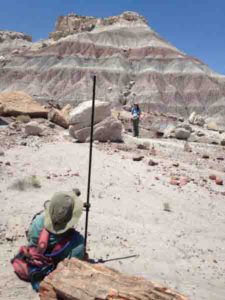
One of the most exciting discoveries that paleontologists can make is finding the causal relationship between the extinction of ancient creatures and the environmental conditions that led to that extinction. A team of scientists and students at the University of Rhode Island is inching closer to revealing how a group of animals from the Late Triassic went extinct, thanks to the precise dating of fossils at Petrified Forest National Park in Arizona.
URI Professor David Fastovsky, who made important discoveries about the extinction of the dinosaurs between the Cretaceous and Tertiary periods 66 million years ago, is leading a team of researchers working to understand what caused the extinction of the near-relatives of North America’s earliest dinosaurs around 215 million years ago.
“Reconstructing extinctions is extremely difficult,” he said, “but at Petrified Forest we have the best-dated ancient river deposits in the world, which allow us to ask very precise questions about this extinction — in particular, whether it was gradual or catastrophic. This could be one of the extremely rare instances in the ancient record when this could actually be determined quantitatively using direct evidence.”
If the researchers determine that all of the animals went extinct at about the same time — rather than gradually over a long period — they may be able to link the animals’ extinction to the catastrophic impact of an asteroid that left a 50-mile-wide crater in Quebec, an impact that some scientists believe was responsible for the extinctions at that time.
Fastovsky has been studying the fossils at Petrified Forest since 1991. He said the rocks there indicate a distinct “faunal turnover” when one set of organisms disappeared and another set of organisms appeared.
“The question is, can we date that faunal turnover, and how precisely,” he said.
Using what he called “high-precision uranium-lead dating” developed by researchers at the Massachusetts Institute of Technology and applied by URI geoscientists in Petrified Forest National Park, Fastovsky is hopeful that his team will have some answers by the end of next year.
To meet that goal, Fastovsky engaged Gavino Puggioni, URI assistant professor of statistics, who is using sophisticated statistical analyses to determine whether the ancient animals all went extinct simultaneously, which would be expected from a catastrophic event.
“The processes that we’re studying took place over thousands of years,” said Puggioni. “We’re trying to extract a very weak signal from this small data set. But there are statistical techniques that can help us identify what we’re observing. We are trying to extend and push the boundaries.”
“This is an unheard-of level of quantitative precision being applied to an extinction event,” added Fastovsky.
To fill in gaps in the existing data, URI graduate student Reilly Hayes and junior Amanda Bednarick spent three months last summer finding the precise locations where more than 100 fossils had been collected from Petrified Forest over the last century. It wasn’t easy.
“River systems like at Petrified Forest tear themselves up when the sediments build up,” explained Hayes. “So you find a lot of discontinuities between the beds of rock. But we already had dates in the model of how certain beds fit together into the larger sequence at the park. We just didn’t know where all the fossils occurred relative to those.”
The dates in the model were first collected by a previous generation of URI researchers, and they run through the full thickness of the rock sequence exposed in the Park, which Fastovsky and his MIT colleagues nicknamed the “backbone.”
Hayes and Bednarick hiked many miles each week last summer and found 51 sites around the park where they could link previously collected fossils with rocks of known age.
“We relocated all these fossil localities, some of which didn’t have exact information for where they were originally found, and then we established a game plan for how to correlate this spot on the ground to a place where the backbone was exposed,” said Bednarick.
Over the next year, additional field work will be required to relocate about 20 more fossil sites, and the statistical analyses will continue. And then the researchers hope to be able to draw conclusions about the cause of the extinction.
“We’re looking forward to testing whether the extinctions occurred at the same time and whether this particular extinction would be concordant with what you would expect if an asteroid did the deed,” concluded Fastovsky. “That would be pretty special.”
Note: The above post is reprinted from materials provided by University of Rhode Island.










